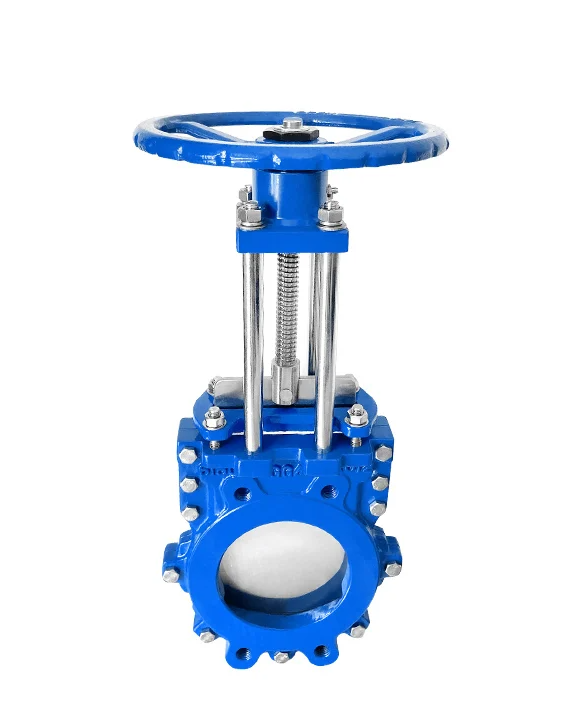
What is a knife gate valve and its uses?
Knife gate valve is similar in design and were initially developed for use in the pulp and paper industry. As the name implies, these valves can cut through thick, porous media that may contain a high concentration of suspended solids (such as dense, sewage sludge) which had caused problems with valves not seating completely and thus leaking.
A knife gate valve works by lifting a plate with a planar or “knife” edge from the path of flow that can cut through various impediments during closing, creating complete closure against a soft sealing surface. This soft sealing surface generally dictates use in rather low-pressure systems and is not designed to handle high pressure. Both gate and knife gate valves are primarily designed for isolation or on/off service rather than a throttled or partial-flow application.
Design & parts of a knife gate valve
Knife gate valves are a specific type of isolation valve that is typically used for media that are not hazardous such as wastewater. The bore of a knife gate valve is full and smooth so the use of a cleaning pig for maintenance is possible. While there is no pressure loss across the valve. They are susceptible to “chatter” or vibration during opening or closing caused by fluid flow against the gate.
This is not a significant issue as the appropriate application for a knife gate valve is isolation, not flow restriction, so the normal operating position is fully open or fully closed. A thin (typically) stainless-steel gate is raised and lowered into the bore by a spindle or rising screw and, unlike other gate valves, lifts outside of the valve body when raised. The guide and seal are located around the circumference of the bore and provide a bi-directional, bubble-tight seal.
Knife gate valves are available with bodies made of cast iron, cast steel, stainless steel, fabricated steel, or exotic alloys depending on the specific application. While the gate is usually made of stainless steel, the yoke can be of similar materials to the valve bodies and may include a brass or bronze bearing. The seat seals can be elastomers or flexible metal. Reference the diagrams below to identify the different parts that are common.
Knife Gate Valve Parts:
- Valve Body: It is usually made of a strong material such as cast iron or stainless steel and contains a flow channel for the fluid.
- Knife Gate: It is a thin plate that has a sharp edge resembling a knife. It rises and lowers inside the valve to allow or block the flow of the fluid.
- Actuation Mechanism: A rising stem or screw can be used to lift and lower the knife gate. The actuation mechanism can be manual or pneumatic/electric.
- Seat Seal: It surrounds the perimeter of the flow channel and provides a bi-directional and airtight seal.
Working theory of knife gate valves
All valves are designed to limit or stop the movement of a liquid in a flow stream. However, there is a myriad of designs and applications that depend on the specific use case. Therefore, there is a slight difference between a gate valve and a knife gate valve in construction. In a typical wedge gate valve, as the name implies, the wedge serves as a “gate” to move into the flow stream and seal off or reduce the flow by impeding the path. A knife gate valve is a specific design of a valve that uses a knife edge that can enter the flow stream and, if necessary, use the edge of the gate to separate any materials that might prevent the valve from sealing completely.
As described above, the knife gate can be raised using a spindle or a rising screw and the actuating mechanism can be manual or pneumatic/electrically activated. The open/closed state of the valve can be observed from the position of the gate – if it is visible above the valve body. Then it is open and likewise, if it is not visible then the valve is closed.
Advantages of a knife gate valve
Many of the advantages of regular gate valves also apply to knife gate valves. They are easy to actuate by mechanical, electrical, or pneumatic means, and they are lightweight which makes them easier to transport, store, install, and maintain (knife gate valves tend to be even lighter than resilient- or metal-seated gate valves). They are also very cost-effective. Because of these attributes, knife gate valves have seen extensive use involving slurry, viscous fluids, and other applications where impingement is an issue and are used not only in pulp and paper production but are also widely used in municipal wastewater pumping stations and sewage treatment plants. Our knife gate valves can also be used for other non-volatile, non-flammable viscous fluids.


























